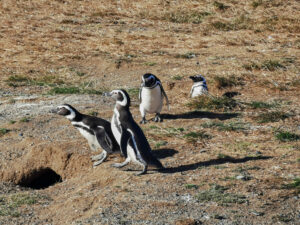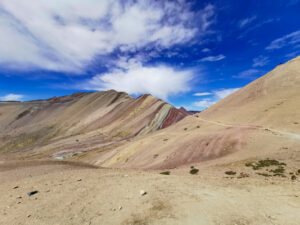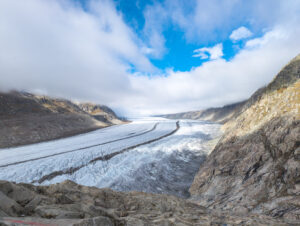Overview: This chapter of the West Coast adventure begins with an early morning on the slopes of Mount Hood, Oregon’s highest peak, before venturing south into the high desert city of Bend. The exploration around Bend includes the scenic Cascade Lakes National Scenic Byway, featuring a challenging snowy hike attempt, serene kayaking, and an adventurous off-road drive to a mountain lookout. The journey then delves into unique geological formations like Skylight Cave and ascends volcanic buttes for breathtaking panoramic views, including Black Butte and Green Ridge Lookout, before concluding with a sunset over Mount Washington. This post offers a guide to these diverse volcanic landscapes and outdoor activities.
Day 10 (previous post): Monday – Mount Hood’s Moods and the Scenic Drive to Bend
- Key Locations Visited: Trillium Lake (attempted sunrise), Timberline Lodge (Mount Hood), Mill Creek Bridge (en route), Peter Skene Ogden State Scenic Viewpoint, Smith Rock State Park.
- Activities: Early morning scenic viewing attempts, scenic driving south, significant hike at Smith Rock State Park.
- Wildlife/Activity Sighting: Slackliners at Smith Rock State Park.
- Overnight Location: Hostel in Bend.
The day commenced at 4:30 AM with ambitions to witness sunrise at Trillium Lake, a location renowned for its mirror-like reflections of Mount Hood. Unfortunately, a complete cloud cover thwarted this photographic aspiration. A subsequent drive up to Timberline Lodge on Mount Hood revealed similar conditions: overcast skies and a significant amount of lingering snow, even in late spring/early summer.
Deep Dive: Mount Hood – Trillium Lake & Timberline Lodge
- Mount Hood: A potentially active stratovolcano in the Cascade Volcanic Arc, it’s Oregon’s highest peak at 11,249 feet (3,429 meters). It’s a major center for recreation, including skiing, climbing, and hiking.
- Trillium Lake: A man-made lake created by damming a tributary of Mud Creek, located about 7.5 miles southwest of Mount Hood. It’s famous for its postcard-perfect reflections of the mountain, especially at dawn and dusk, making it a favorite spot for photographers. The lake is also popular for fishing, camping, and non-motorized boating.
- Timberline Lodge: A National Historic Landmark, this grand mountain lodge was constructed between 1936 and 1938 by the Works Progress Administration (WPA) and Civilian Conservation Corps (CCC) during the Great Depression. Located at an elevation of nearly 6,000 feet on the south slope of Mount Hood, it showcases remarkable craftsmanship in wood and stone. It gained cinematic fame as the exterior of the Overlook Hotel in Stanley Kubrick’s 1980 film The Shining. Timberline offers the longest ski season in North America, with summer skiing often available on the Palmer Glacier.
Given the suboptimal weather on Mount Hood, the decision was made to proceed directly south towards Bend, a city in Oregon’s high desert region, where clearer skies were anticipated. The drive itself was scenic, with several notable stops:
- Mill Creek Bridge: A significant crossing, likely offering views of its namesake creek or the valley it carves. (Specific details depend on which Mill Creek Bridge, as the name is common).
- Peter Skene Ogden State Scenic Viewpoint: Located north of Terrebonne, this viewpoint provides dramatic vistas into the deep, 300-foot Crooked River Gorge. Several bridges span the gorge here, including the historic Crooked River High Bridge (1926, now a pedestrian walkway) and newer highway bridges for US 97. It’s also a site for bungee jumping. The viewpoint is named after Peter Skene Ogden, a prominent 19th-century fur trader and explorer for the Hudson’s Bay Company who extensively explored the Pacific Northwest.
- Smith Rock State Park: This was a major highlight of the day. An extensive hike here revealed the park’s stunning beauty. Smith Rock is internationally renowned for its towering cliffs of volcanic tuff and basalt, making it a premier rock climbing destination.
Deep Dive: Smith Rock State Park
- Geology: The park’s dramatic rock formations are primarily composed of layers of welded tuff (compacted volcanic ash from ancient eruptions of the Crooked River Caldera, part of the John Day Formation) and basalt lava flows. The Crooked River has carved its way through these layers, creating the striking cliffs and spires. Misery Ridge and Monkey Face are iconic formations.
- Rock Climbing Mecca: Considered by many to be the birthplace of modern American sport climbing, Smith Rock offers thousands of climbing routes on its varied rock faces, attracting climbers from around the world.
- Hiking and Other Activities: Beyond climbing, the park has numerous hiking trails, including the popular Misery Ridge Trail, which offers strenuous climbs and rewarding panoramic views. Other activities include trail running, mountain biking (on designated trails), wildlife viewing (golden eagles, prairie falcons, mule deer, river otters), and photography.
- Slacklining/Highlining: The park’s dramatic chasms also make it a popular spot for slacklining and highlining, where individuals balance on narrow webbing strung between rock formations. Several slackliners were observed during this visit, showcasing impressive skill and nerve.
Later, at the hostel in Bend, a chance encounter with the same slackliners from Smith Rock led to a conversation about the sport. They mentioned its significant popularity in Switzerland, even hosting world championships (e.g., in Laax), where it’s recognized more formally as a sport than in the US.
A brief visit to Sawyer Park in Bend was made, but it didn’t compare to the natural grandeur of Smith Rock. Upon arrival in Bend, accommodation was secured at the town’s only hostel for two nights.
The evening concluded with a run in a local park around 5:00 PM, leading to a spontaneous two-hour frisbee game with friendly locals. Back at the hostel, conversations with other travelers filled the time before bed.




























Day 11: Tuesday – Cascade Lakes Byway: Snow, Kayaks, and Mosquitoes
- Key Locations Visited: Cascade Lakes National Scenic Byway, Green Lake (attempted hike), Lava Lake, Davis Mountain Lookout Road.
- Activities: Scenic driving, challenging snow hike, kayaking, off-road driving to a viewpoint.
- Overnight Location: Hostel in Bend.
The morning’s agenda focused on the Cascade Lakes National Scenic Byway, a route highly recommended for its stunning volcanic scenery, which had reportedly just opened for the season.
Deep Dive: Cascade Lakes National Scenic Byway
- Route and Landscape: This 66-mile (106 km) scenic drive winds through the Deschutes National Forest in the Central Oregon Cascades. It begins west of Bend and travels past numerous lakes, lava flows, and under the gaze of prominent volcanic peaks like the Three Sisters (North, Middle, and South Sister), Broken Top, and Mount Bachelor.
- Volcanic Origins: The entire landscape is a product of intense volcanic activity over millions of years. The lakes were often formed by lava flows damming rivers or filling depressions left by volcanic eruptions or glacial action.
- Recreation: The Byway provides access to a vast array of recreational opportunities, including hiking (e.g., trails to Green Lakes, Tumalo Mountain, Sparks Lake), fishing, boating (kayaking, canoeing, paddleboarding), camping, and winter sports (when conditions allow).
- Seasonal Access: Due to high elevation and significant snowfall, large portions of the Byway are typically closed from late fall through late spring or early summer. The opening date varies each year depending on snowpack.
The first objective was a hike to Green Lakes. At the trailhead, the path was entirely snow-covered. Despite this, the hike was attempted. After approximately an hour of trekking through increasingly deep snow, the decision was made to turn back due to concerns about softening snow conditions making the descent overly difficult and time-consuming. While the destination wasn’t reached, the experience of hiking through a deeply snow-covered forest was novel and enjoyable.
Continuing along the Byway, the snow situation improved at lower elevations. Various stops were made at different lakes. At Lava Lake, a kayak was rented for an hour ($16). This proved to be a serene and breathtaking experience, being the sole kayaker on the lake, surrounded by stunning views of snow-capped mountains.
Deep Dive: Lava Lake
- Formation: Lava Lake, and its nearby twin Little Lava Lake (headwaters of the Deschutes River), were formed by lava flows from nearby volcanic vents that dammed watercourses.
- Characteristics: Known for its clear waters and excellent fishing, particularly for rainbow and brook trout. It’s a popular spot for non-motorized boating and offers beautiful views of Mount Bachelor and the Three Sisters.
Upon returning the kayak, a local advised returning for sunset, noting the current clarity of the views was exceptional. This advice was heeded.
Before returning to Lava Lake, an unpaved road, “Davis Mountain Lookout Rd,” was spotted and explored. This road ascended steadily, offering progressively more expansive views over Davis Lake, Wickiup Reservoir, and the South Sister volcano. The solitude and panoramic vistas were a rewarding detour.
Returning to Lava Lake in the late afternoon, well before sunset, provided an opportunity to write. However, the mosquitoes were relentless and intense. Another visitor, observing the scene, expressed astonishment at the ability to endure the biting insects.
The sunset at Lava Lake, while pleasant, did not rank among the most spectacular witnessed on the trip. The return drive to Bend featured very straight roads, allowing for (perhaps imprudently) high speeds on deserted stretches. The evening at the hostel involved more conversations before retiring.
























Day 12: Wednesday – Subterranean Light Beams and Volcanic Summits
- Key Locations Visited: Skylight Cave, Black Butte, Green Ridge Lookout, Mt. Washington Viewpoint.
- Activities: Cave exploration, hiking/trail running up Black Butte, off-road driving to Green Ridge Lookout, sunset viewing.
- Overnight Location: Slept in car on a side road near the N Santiam Hwy.
With an open agenda, an online search led to Skylight Cave. The drive involved a considerable stretch of unpaved road into a remote area. Upon arrival, the site was unassuming: simply a hole in the ground with a ladder descending into darkness. Equipped with a headlamp and jacket (as lava tubes are consistently cool), and after sending a location pin to family as a precaution, the descent began. The cave, a lava tube, is not overly complex, making it difficult to get seriously lost. Soon, the famed sunbeams were visible, piercing through openings in the cave ceiling. The visit was around 1:00 PM; an earlier time (e.g., 10:00 AM) is often recommended for more direct and dramatic light beams, as these were already angled towards the cave wall.
Deep Dive: Skylight Cave (Lava River Cave System)
- Formation: Skylight Cave is a lava tube, part of a larger system of lava tubes near Newberry Volcano. Lava tubes are formed when the outer surface of a flowing lava river cools and solidifies, creating a crust. The molten lava inside continues to flow, and when the flow ceases and drains away, a hollow tube remains. The “skylights” are sections where the roof of the tube has collapsed, allowing light (and access) from the surface.
- Best Viewing Times: The dramatic light beams are best observed on clear, sunny days, typically during late spring and summer. The optimal time for viewing varies depending on the specific skylight and the angle of the sun, but mid-morning (around 8 AM to 11 AM, sometimes later for certain beams) is often cited.
- Safety and Preparation: Visitors should carry multiple light sources (headlamps are ideal), wear sturdy shoes, and dress in layers as the cave temperature remains cool year-round (around 40-45°F / 4-7°C). The floor can be uneven and rocky. It’s managed by the Deschutes National Forest and is typically accessible from May to September, snow permitting.
After Skylight Cave, Eugene was set as a potential next destination. However, en route, the snow-free summit of Black Butte proved an irresistible detour. A road led most of the way up, followed by a final ~1-hour hike (approx. 2 miles) to the summit. The views were outstanding.
Deep Dive: Black Butte
- Geology: A prominent and symmetrical extinct stratovolcano located near Sisters, Oregon, Black Butte rises approximately 3,000 feet above the surrounding plain to an elevation of 6,436 feet (1,962 meters). It’s significantly younger than the nearby major Cascade Range volcanoes, having formed about 1.5 million years ago.
- Summit and Lookout: The summit offers panoramic 360-degree views of the Central Oregon Cascades, including the Three Sisters, Mount Jefferson, Mount Washington, and Three Fingered Jack. A historic fire lookout tower (the current Cupola Lookout is a replica of an original 1920s structure, though the first lookout was built in 1910) is located on the summit, accessible by a well-maintained trail. The trail gains about 1,600 feet in elevation from the upper trailhead.
During the ascent, a trail runner was encountered. He had started from the base of the mountain, a more strenuous endeavor than the hike from the upper parking lot. He recommended also visiting Green Ridge Lookout. After enjoying the summit views, the descent was made, followed by a drive to Green Ridge Lookout. This involved more unpaved roads, with the initial route choice proving to be in poor condition; a better route was found for the return. Navigating these backroads can be challenging for non-locals.
The view from Green Ridge Lookout was truly incredible, offering what might be the best perspective of Mount Jefferson in the region. It ranked among the most stunning scenic viewpoints ever experienced. The historic fire lookout tower here can even be rented for overnight stays (though it’s extremely popular and books up far in advance). Sleeping in such a location would be unparalleled.
Deep Dive: Green Ridge Lookout & Mount Jefferson
- Green Ridge: A long, north-south trending ridge on the eastern flank of the Cascade Mountains, offering spectacular views. The lookout provides a particularly dramatic vantage point.
- Mount Jefferson: Oregon’s second-highest peak (10,497 feet / 3,199 meters), Mount Jefferson is a deeply eroded stratovolcano known for its rugged, glaciated appearance. It’s located within the Mount Jefferson Wilderness area. The view from Green Ridge showcases its prominent west face and the surrounding wilderness.
- Lookout Rentals: Many historic fire lookouts in National Forests across the US are part of a rental program managed by Recreation.gov, offering unique and rustic accommodation experiences.
Inspired by a road seen from Black Butte, the N Santiam Hwy (US-20 / OR-126) was chosen for the next leg of the drive. Around sunset, the Mt. Washington Viewpoint along this highway provided another amazing visual spectacle as the sun dipped, illuminating the rugged peak. After lingering to absorb the scene, a quiet side road was found for an overnight stay in the car.





















Day 13: Thursday, May 29th, 2025 – McKenzie River Waterfalls
- Key Locations Visited: Sahalie Falls (McKenzie River).
- Activities: Scenic driving, short waterfall visit.
After a night of somewhat restless sleep, the journey continued on Thursday, May 29th, 2025. A detour was made to visit Sahalie Falls on the McKenzie River. The weather, while not as brilliantly sunny as previous days, remained good.
Deep Dive: Sahalie and Koosah Falls (McKenzie River National Recreation Trail)
- Location: Located along the McKenzie River National Recreation Trail, accessible from Highway 126 (McKenzie Highway).
- Sahalie Falls: “Sahalie” is a Chinook Jargon word meaning “high” or “heaven.” This powerful waterfall sees the McKenzie River plunge approximately 100 feet (30 meters) over a natural lava dam.
- Koosah Falls: Located just a short distance downstream from Sahalie, “Koosah” also means “sky” or “heaven” in Chinook Jargon. It drops about 70 feet (21 meters) in a similar dramatic fashion.
- Trail System: An easy, well-maintained loop trail connects Sahalie and Koosah Falls, winding through lush old-growth forest along the river. The trail offers multiple viewpoints of both falls. The water here is known for its striking turquoise color, a result of its purity and the way light refracts through it.
The power and beauty of Sahalie Falls were impressive, a fitting natural spectacle to mark this point in the journey. Next Post.




